As someone with a strong connection to the Ruhrgebiet in Germany, and in particular to the city of Duisburg, I want to congratulate the University of Duisburg Essen to their stroke of genius 20 years ago in recruiting Dr George Iliakis as their faculty member and professor for medical radiation biology.
Professor Iliakis used to work at the Kimmel Cancer Center at Thomas Jefferson University, Philadelphia, USA, and there he published his groundbreaking research on DNA damage and DNA repair, all of which will certainly pave the way to curing cancer. With Photoshop. Lots of it. You won’t believe how much, because the early 2000s were the Golden Age of Photoshop in biomedical sciences and everyone was doing it like there is no tomorrow. Come to think of it, many, if not all, of our today’s venerable grand old patriarchs of cancer research made it to where they are now also thanks to a certain artistic attitude to research data. Everyone wants their share of that past Photoshop stardom, and this is why the University Duisburg-Essen has cancer solved, all thanks to Professor George Iliakis.
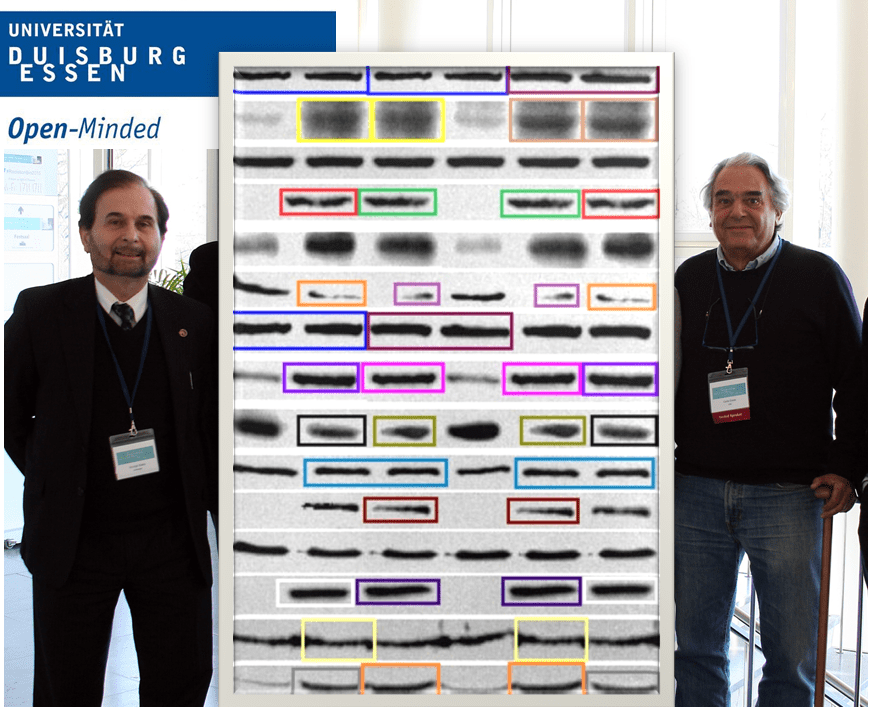
Iliakis is one of these great old men of science we are supposed to admire, because they did so much for cancer research. A native Greek, Iliakis did his PhD in Frankfurt, Germany. In early 1980ies he moved to USA, because this is how German academia worked. You do your doctoral degree, then you go to America for some years, and then you return to your waiting faculty chair, celebrated as the master of the great art of American science, which is truly superior to everything the rest of the world ever achieved.
Iliakis stayed in USA for 18 years, and made a great career at Kimmel Cancer Center, as director of the Division of Experimental Radiation Oncology. But at some point Iliakis mysteriously had enough of American money and fame, so he left his huge American salary and his gigantic NIH funding behind, in order to move to the world-renowned university clinic of the world-top-ranking University of Duisburg-Essen in world’s fanciest location, the Ruhrgebiet, surprisingly modestly funded by the DFG. Professor Iliakis will soon retire, having trained many young scientists in the high art of cancer research.
Now the image integrity sleuth Clare Francis looked at some of Iliakis papers from USA, posted his finds on PubPeer, and found artistic beauty where others would find despair.
J Guan , E Stavridi , DB. Leeper , G Iliakis Effects of hyperthermia on p53 protein expression and activity Journal of Cellular Physiology (2002) DOI: 10.1002/jcp.10069

Now, p53 is a very important protein in cancer research, and it can do funny things under hyperthermic conditions. Somehow some bands from Figure 1C cloned and inserted themselves into the gels of Figure 1B, having been cooled from 41°C to 37°C. Professor Iliakis and his first author Jun Guan however explained that this is perfectly OK:
“We noticed this issue before sending out our work for publication. As I mentioned in my previous comment, the highlighted bands of each control circled in the red and blue boxes were obtained in different experiments.”
For them, the issue is closed. Neither Iliakis nor Guan ever commented again, which is a pity.
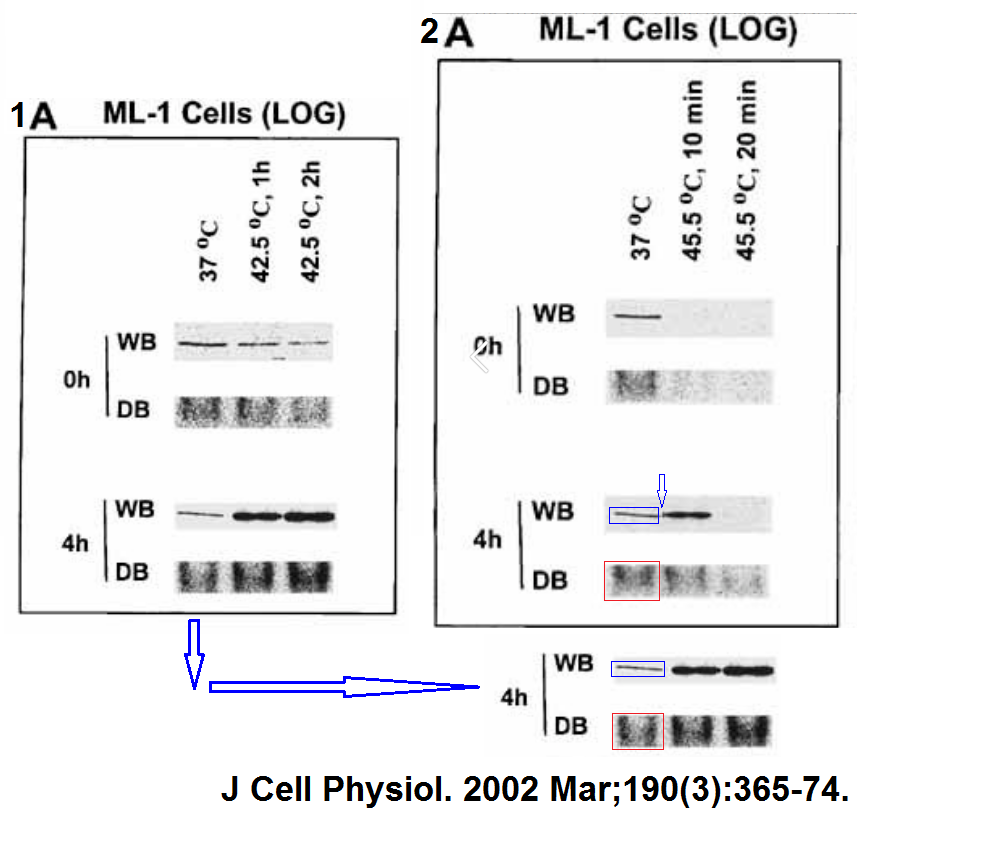
Wang H, Perrault AR, Takeda Y, Qin W, Wang H, Iliakis G. Biochemical evidence for Ku-independent backup pathways of NHEJ Nucleic Acids Research (2003) doi: 10.1093/nar/gkg728
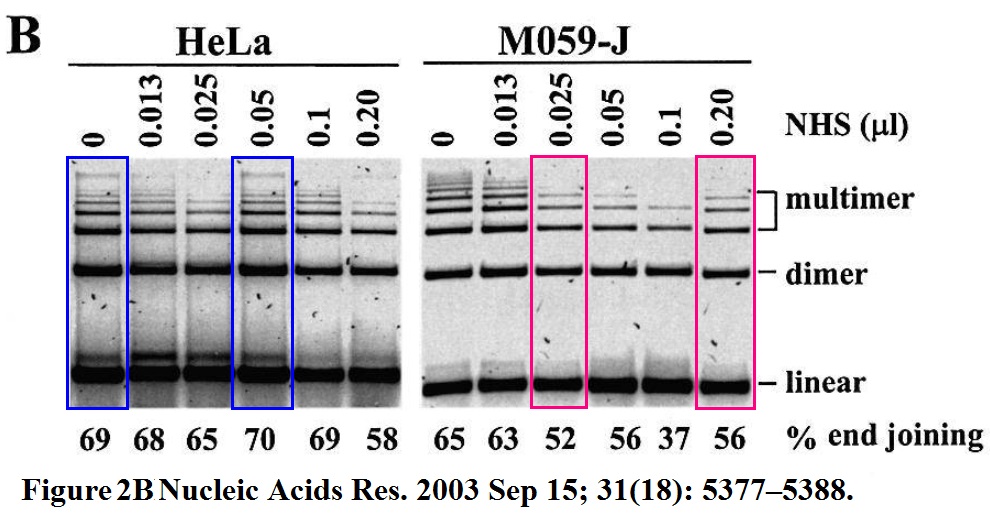
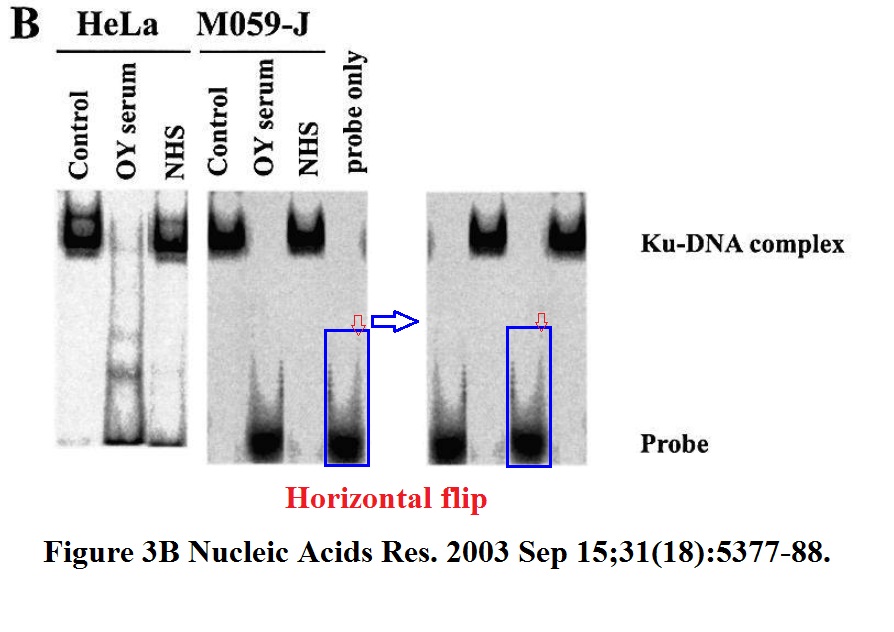
In these examples, Professor Iliakis’ group studied non-homologous end-joining (NHEJ) DNA repair and found out it to be actually a splicing tool in Adobe Photoshop. Basically, here damaged academic pride activates a Photoshop-mediated figure recombination process, where a piece of gel lanes gets replicated and spliced where it achieves novel results.
One year later, in the same journal, Iliakis studied how DNA is replicated after damage. It turned out, the same mechanism replicates gel bands, quite hilariously so.
X Wang , J Guan , B Hu , RS Weiss , G Iliakis , Y Wang Involvement of Hus1 in the chain elongation step of DNA replication after exposure to camptothecin or ionizing radiation Nucleic Acids Research (2004) doi: 10.1093/nar/gkh243
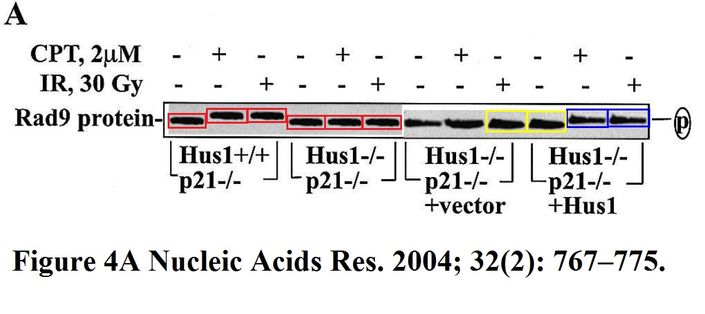
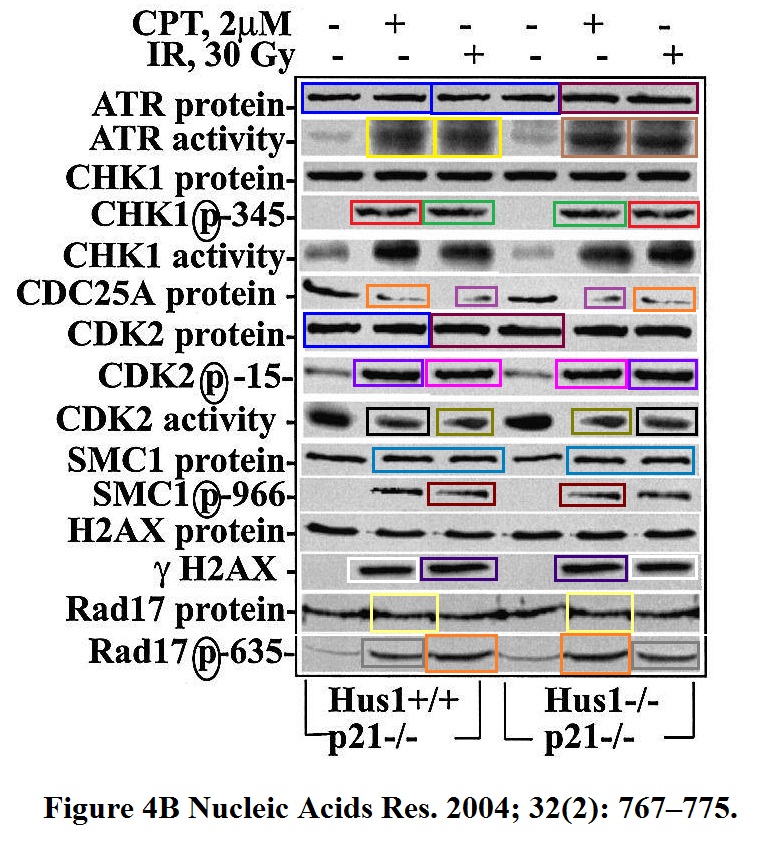
In America, they do big science and they do it properly. What you see here, is advanced US technology, sponsored by many millions from NIH. Of course University of Duisburg-Essen was honoured to host such star scientist in their university clinic. Just look at this high-tech gel:
Clare Francis suggested this figure looks like an artwork by Paul Klee.
Even the Editor-in-Chief of the journal Nucleic Acids Research (NAR) and University of Southampton professor Keith Fox was impressed by the artwork. Fox replied to Clare Francis in January 2020:
“Thank you for drawing these things to our attention. We will investigate and take any appropriate action.”
It is not clear which action Fox meant, since his own NAR until recently used to have a policy not to do anything about papers older than 2 years. The usual action NAR editors take in such cases, is to write to authors not to worry since the journal does not to intend to act in any way.

Much of Iliakis’ groundbreaking research at Kimmel Cancer Center, like this beautiful Wang et al NAR 2004 paper, was done in collaboration with the radiation oncologist Ya Wang, originally from China. Professor Wang now moved on to the Winship Cancer Institute of Emory University in Atlanta, where she continues to receive much NIH money for her extraordinary cancer research. Wang’s specific qualifications are certified by around 20 papers flagged on PubPeer for Photoshop data enhancement.
This Iliakis-Wang collaboration is also artistically valuable, even if somewhat lazily executed.
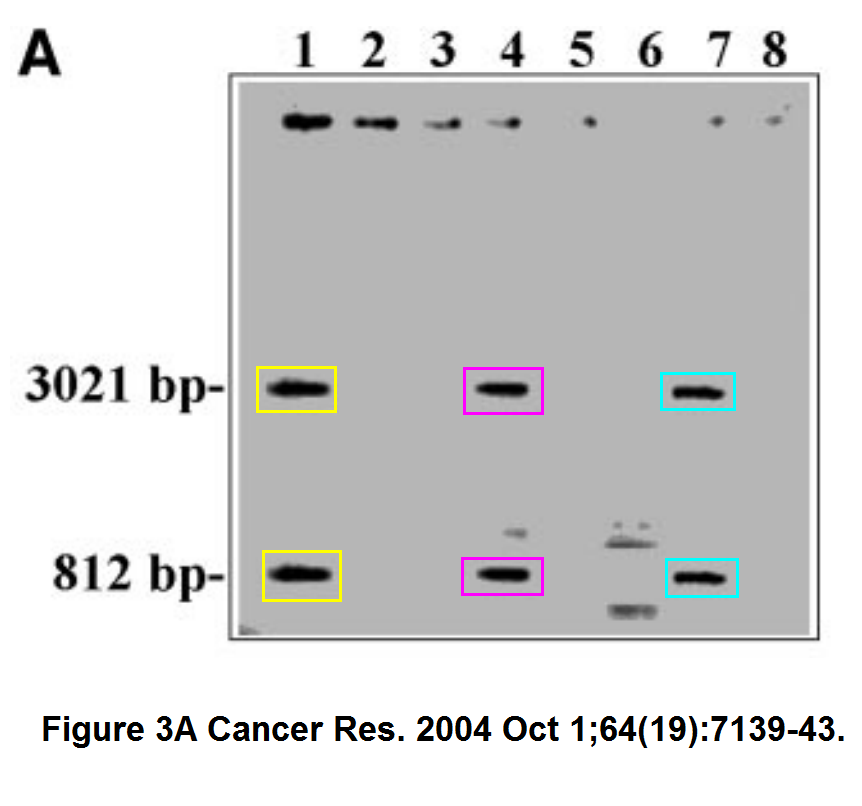
H Wang, H Wang, SN. Powell, G Iliakis, Y Wang ATR affecting cell radiosensitivity is dependent on homologous recombination repair but independent of nonhomologous end joining Cancer Research (2004) doi: 10.1158/0008-5472.can-04-1289
What happens when you irradiate cells, is that gel bands get replicated in the process of non-homologous end joining.
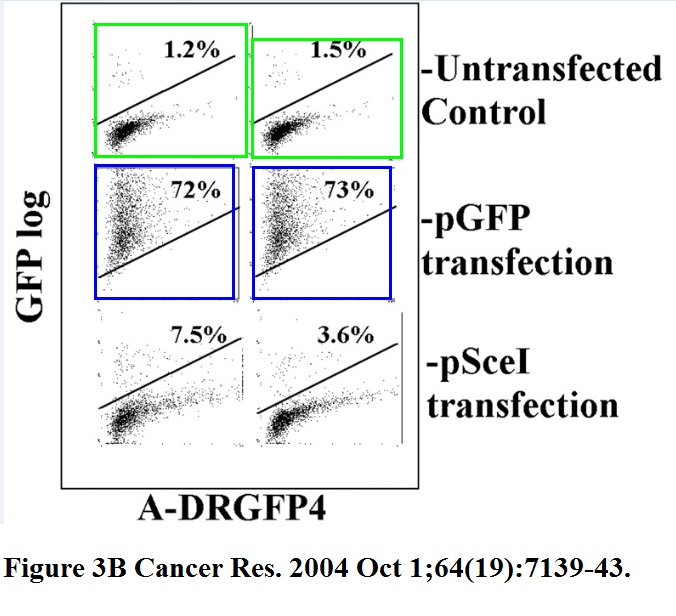
That we already learned, from other Iliakis studies. But there is also this process of homologous recombination, where flow cytometry plots get replicated and recombined with different numbers. That happens when fantastic research needs to be published in a journal where nobody cares about such things. As AACR journal Cancer Research at least used to be. In fact, in 2002, Iliakis and Wang placed two papers in Cancer Research which have certain artistic quality to them.
X Wang , GC Li , G Iliakis , Y Wang Ku affects the CHK1-dependent G(2) checkpoint after ionizing radiation Cancer Research (2002) Nov 1;62(21):6031-4.
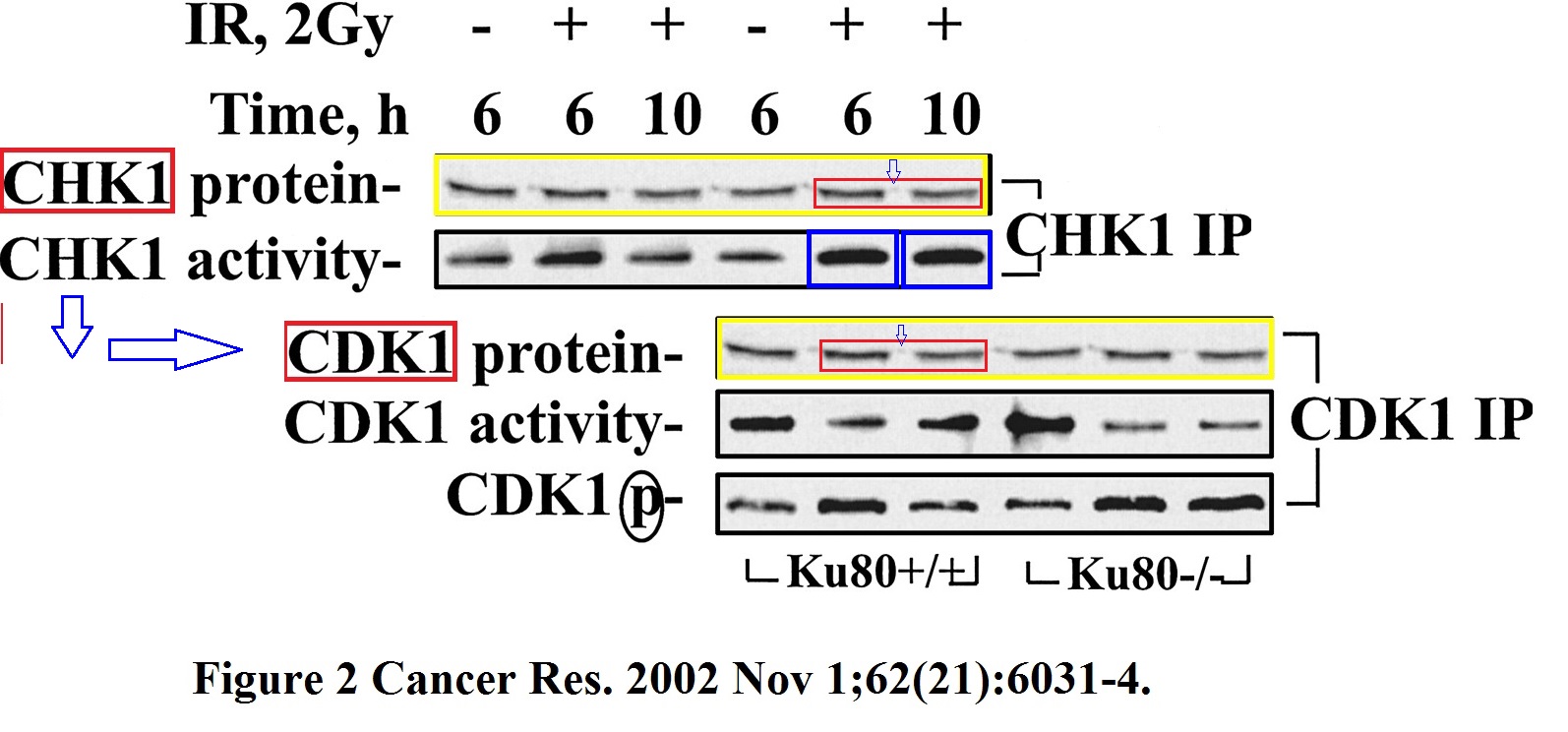
Apparently, there is a kind of checkpoint activated by the DNA damage where gel bands are forced, under gun point presumably, to exit their gel vehicles and join some previously arrested gel bands inside a different panel of the same figure, for interrogation. Sometime these gel bands are just shuffled back and forth inside same gel until they admit to smuggling and document forgery, like in this other Cancer Research paper:
XY Zhou , X Wang , B Hu , J Guan , G Iliakis , Y Wang An ATM-independent S-phase checkpoint response involves CHK1 pathway Cancer Research (2002) Mar 15;62(6):1598-603.

The paper recycles a blot from Zhou et al 2002 (by Profs Wang and Iliakis). Also,two Cancer Research papers from 2002 share a joint figure, even if they are supposed to show different experiments with different antisense oligonucleotide sequences:

As reminder, these papers were all published after 2001, when Iliakis moved to Essen, most of them bear his Ruhrgebiet affiliation. I personally am enormously proud for the University of Duisburg-Essen. Professor Iliakis is an asset, may he never retire.
Update 23.09.2021
Retraction Watch now reported that Ya Wang was found guilty of research fraud by HHS-ORI:
“Ya Wang, who retired from Emory a year ago, “falsified protein immunoblot data by reusing and relabeling the same images to represent different experimental conditions in mammalian tissue culture models of DNA damage and repair in eighteen (18) figure panels in eleven (11) figures in one (1) grant application and six (6) published papers,” the ORI said.
Wang “neither admits nor denies” ORI’s findings of misconduct, according to the agency’s report on the case. She agreed to a four-year ban on any federal funding, and to correct or retract four papers..”
Iliakis is not co-author on any of these four. But Wang previously retracted 3 other papers, including the disastrous Wang et al NAR 2004 with Iliakis. So what did the University of Duisburg-Essen determine?
In April 2020, the university’s Ombudsman Ulrich Dührsen informed me:
“My investigation showed that the experiments described in the papers were carried out exclusively at the Thomas Jefferson University of Philadelphia. In no case was any data reported that was generated at the University of Duisburg-Essen.
During his time in Philadelphia, Prof. Iliakis was involved in the collection of data and their graphical representation for two of the total of nine publications. In a case that Prof. Iliakis has already commented on in PubPeer and which will shortly be explained in more detail with further information, in my opinion there was no reliable evidence of scientific misconduct [Guan et al 2020, -LS]. In the second case, as you and PubPeer suspect, several images were actually manipulated. An employee of Prof. Iliakis from his period of employment in Philadelphia confessed to this. The journal was informed of this fact, and the editor’s reaction to this misconduct will be published shortly [the retracted Wang et al 2004, the confessor being presumably Jun Guan, -LS].
In seven publications, Prof. Iliakis’ contribution was limited to assistance in embedding the results in the scientific knowledge and editing the text for an English-language journal. Prof. Iliakis was not involved in obtaining the research results and their graphic representation. He stated that at the time the manuscripts were prepared, he had no reason to believe that the data had been tampered with. The last author on this work was Prof. Ya Wang, who, after Prof. Iliakis moved to Essen in 2001, took over the management of the Department of Radiation Oncology at the Thomas Jefferson University of Philadelphia and later moved to the Emory University of Atlanta.
In summary, most of the evidence of scientific misconduct you have compiled was understandable to me. In no case were there any indications of an active role by Prof. Iliakis or his Essen working group in the suspected data manipulation. The investigation at the University of Duisburg-Essen was therefore terminated. At the same time, the ombudspersons of the Thomas Jefferson University of Philadelphia and the Emory University of Atlanta were informed of the suspected data manipulation.“
Back then, I was asked to treat this information confidentially, but now I informed Dührsen that I intend to publish the above statement to inform my readers, unless he has any updates. Dührsen, who despite retirement remains the university’s Ombudsman, hinted that nothing changed since. Meaning, Iliakis was never investigated for the research he used to obtain grants and a professorship in Germany.
The guideline of the University Duisburg-Essen which the university itself provided me with, defines in §6g “Scientific Misconduct” as
“Active participation in the misconduct of others, especially
- through collusive collaboration in the case of forgeries committed by others, or
- through the co-authorship of publications containing falsifications“
I guess this applies to students only.

Donate!
If you are interested to support my work, you can leave here a small tip of $5. Or several of small tips, just increase the amount as you like (2x=€10; 5x=€25). Your generous patronage of my journalism will be most appreciated!
€5.00


Carlo Croce has proudly said he has an eye for masterpieces. The Paul Klee imitation could be a part of his collection.
Is the best analogy that of non-homolgous recombination, or multiple transposons at work?
I really believe that if the deadwood and cheating faculty were to magically disappear (that would indeed be great magic), 1/2 the faculty would be gone, and probably more than half of the NIH grant money would be no longer wasted on overheads for deadwood salaries and supplies for crap data from cheater labs.
I think my inscription on my tombstone might be: “I’m dead, sure, but at least I wasn’t deadwood.”
LikeLike
Can you imagine if the NIH was actively looking at fraud in its current grant applications? even better, if they were to retroactively search for fraud in funded research?
LikeLike
” Professor Wang now moved on to the Winship Cancer Institute of Emory University in Atlanta, where she continues to receive much NIH money for her extraordinary cancer research. Wang’s specific qualifications are certified by around 20 papers flagged on PubPeer for Photoshop data enhancement.”
Because of the relatively few Chinese surnames the Pubpeer link includes some who are not Ya Wang.
Individual publications for Ya Wang at Pubpeer:-
https://pubpeer.com/publications/7C72D7E9C8A890CEB3047CFC589551
https://pubpeer.com/publications/EE6997F1FB6F9335BD0551EE7D3636
https://pubpeer.com/publications/066655B948187638D608BD75D1B50D
https://pubpeer.com/publications/18A0E30C6D4205E360B669E22FF51A
https://pubpeer.com/publications/AFBB0B94FDAB595CC55B1749C1D3F3
https://pubpeer.com/publications/2F179E20A4CCC0F24F6967A12C60D5
https://pubpeer.com/publications/3BBE9AC981E17776992228B6853F13
https://pubpeer.com/publications/98D85BC9346DAC066C712EA71BA0C8
https://pubpeer.com/publications/61FD90D5A9980A4FC629A25A0E398B
https://pubpeer.com/publications/8E0171A08C96EB7E1A87CD8DBAB867
https://pubpeer.com/publications/FD1029AC5D8F9576E6E74A5DFD4619
https://pubpeer.com/publications/D3BAD4F56E914C444ED0287839AF92
https://pubpeer.com/publications/6776A10A9EFF5FC9B56F44B7BA4B9B
https://pubpeer.com/publications/806266B39DC76070FCED5B21B50E7A
https://pubpeer.com/publications/7499ABC79483C2B03875C70103743A
https://pubpeer.com/publications/DC2564045814E6CDC89A7A980291C4
https://pubpeer.com/publications/FD71866CC27696DA5AB6FFADAD76B6
LikeLiked by 1 person
Hmmm…. Wang, Dang, Dong, Wong, Yi, Wu….this kind of reminds me of Georgia State:
https://retractionwatch.com/2020/01/13/georgia-state-researcher-up-to-nine-retractions-disagrees-with-the-journal/
Publishing is fun and profitable if you don’t have to follow any kind of rules!
LikeLike
Kentucky fried chicken!
https://retractionwatch.com/2019/08/23/university-of-kentucky-moves-to-fire-researchers-after-misconduct-finding/
LikeLike
Indeed. I suspect these individuals who ran the labs, and in particular the individuals who carried out the fradulent experiments, have careers that are not yet over. Seems like it would be an advantage for a PI to get someone who is willing to bend the rules a little bit (or a lot) to work in the lab. These people deliver. All they need to be do is improve their photoshop skills.
I think what could be useful is that some journals are purposely sacrificed (eg, J Cell Biochem) for the publication of fradulent data. I really dont think you can stop cheating as long as there is a strong incentive to, and they can just publish there crap there. Sorta of a well-known secret wink, wink kind of thing. Then the NIH knows who to stop funding. Well, its a fun thought.
LikeLike
NASA has come a long way.
From the 1950s until the 1980s NASA employed Katherine Johnson.
From the 1960s to 1980s NASA employed John Aaron.
In the 2000s and 2010s NASA employs Ya Wang.
https://www.nasa.gov/feature/nasa-selects-nine-proposals-to-support-astronaut-health-on-long-duration-missions
” Ya Wang, Emory University in Atlanta: “Study space radiation-induced lung tumorigenesis” ”
This one has something of the Mission to Mars about it. NASA-funded even!
Life Sci Space Res (Amst). 2015 Nov;7:53-6. doi: 10.1016/j.lssr.2015.08.004. Epub 2015 Sep 14.
Radiation activated CHK1/MEPE pathway may contribute to microgravity-induced bone density loss.
Zhang X1, Wang P1, Wang Y2.
Author information
1
Department of Radiation Oncology, Emory University School of Medicine and Winship Cancer Institute of Emory University, Atlanta, GA 30322, USA.
2
Department of Radiation Oncology, Emory University School of Medicine and Winship Cancer Institute of Emory University, Atlanta, GA 30322, USA.
This work is supported by grants from the National Aeronautics and Space Administration (NNX11AC30G to Y.W. and P30CA138292 to the Institute).
Figure 2. Much more similar than you would expect.
https://imgur.com/t3uNtWP
Figure 3. Much more similar than you would expect.
https://imgur.com/2K58pQz
https://pubpeer.com/publications/18A0E30C6D4205E360B669E22FF51A
LikeLike
“Kimmel Cancer Center at Thomas Jefferson University”.
Is there something about the ecological niche?
https://honours.pmc.gov.au/honours/awards/2004645
Thomas Jefferson University, and University Hospital Philadelphia
“Director, Sidney Kimmel Cancer Centre, 2005-2015.”
“Georgetown University and University Hospital, Washington, DC”
2002-2005.
Albert Einstein College of Medicine, New York
1996-2002.
Pubpeer record.
https://pubpeer.com/search?q=pestell
LikeLike
What disturbs me about many papers by George Iliakis is the lack of data which can be scrutinised. Many papers show graphs, which we have to take a face value. David Latchman also has many publications where there are only graphs.
LikeLike
Problematic data Director of the Gastrointestinal Oncology Program Winship Cancer Institute of Emory University
https://winshipcancer.emory.edu/bios/faculty/el-rayes-bassel.html
Angiogenesis. 2013 Oct;16(4):903-17.
Angiogenesis. 2013 Oct;16(4):903-17. doi: 10.1007/s10456-013-9364-7. Epub 2013 Jul 10.
Antiangiogenic effects of ganetespib in colorectal cancer mediated through inhibition of HIF-1α and STAT-3.
Nagaraju GP1, Park W, Wen J, Mahaseth H, Landry J, Farris AB, Willingham F, Sullivan PS, Proia DA, El-Hariry I, Taliaferro-Smith L, Diaz R, El-Rayes BF.
Author information
1
Department of Hematology and Medical Oncology, Emory University, 1365 Clifton RD NE, Office 2080, Atlanta, GA, 30322, USA.
Figure 6b. Much more similar than you would expect.
LikeLike
https://winshipcancer.emory.edu/bios/faculty/el-rayes-bassel.html
Education
After completion of the residency, he joined the hematology oncology fellowship program at the Karmanos Cancer Institute at Wayne State University.
Mol Cancer Ther. 2004 Nov;3(11):1421-6.
Cyclooxygenase-2-dependent and -independent effects of celecoxib in pancreatic cancer cell lines.
El-Rayes BF1, Ali S, Sarkar FH, Philip PA.
Author information
1
Department of Hematology and Oncology, Karmanos Cancer Institute, Wayne State University, 4100 John R. Street, Detroit, MI 48201, USA.
https://pubpeer.com/publications/6468FFE1ACB20CC65658915E3C0024
Figure 4. Much more similar than you would expect.
LikeLike
2016 retraction for Director of the Gastrointestinal Oncology Program Winship Cancer Institute of Emory University
https://winshipcancer.emory.edu/bios/faculty/el-rayes-bassel.html
J Cell Biochem. 2010 May;110(1):171-81. doi: 10.1002/jcb.22523.
Concurrent inhibition of NF-kappaB, cyclooxygenase-2, and epidermal growth factor receptor leads to greater anti-tumor activity in pancreatic cancer.
Ali S1, Banerjee S, Schaffert JM, El-Rayes BF, Philip PA, Sarkar FH.
Author information
1
Division of Hematology/Oncology, Karmanos Cancer Institute, Wayne State University, Detroit, Michigan 48201, USA.
https://pubpeer.com/publications/A3845DA138FC83780CB5071ED74AEC
2016 retraction notice.
https://onlinelibrary.wiley.com/doi/10.1002/jcb.25586
The above article, published online on March 8, 2010 in Wiley Online Library (wileyonlinelibrary.com), has been retracted by agreement between the journal Editor in Chief, Gary S. Stein, and Wiley Periodicals, Inc. The retraction has been agreed following an investigation from Wayne State University involving the first author and the corresponding author that found Figures 2A, 4, 6A, and 6C to be inappropriately manipulated.
REFERENCE
Ali S, Banerjee S, Schaffert JM, El‐Rayes BF, Philip PA, Sarkar FH. 2010. Concurrent inhibition of NF‐κB, cyclooxygenase‐2, and epidermal growth factor receptor leads to greater anti‐tumor activity in pancreatic cancer. J Cell Biochem 110:171–181; doi: 10.1002/jcb.22523
LikeLike
2018 retraction for Director of the Gastrointestinal Oncology Program Winship Cancer Institute of Emory University
https://winshipcancer.emory.edu/bios/faculty/el-rayes-bassel.html
Cancer Res. 2006 Nov 1;66(21):10553-9.
Potentiation of the effect of erlotinib by genistein in pancreatic cancer: the role of Akt and nuclear factor-kappaB.
El-Rayes BF1, Ali S, Ali IF, Philip PA, Abbruzzese J, Sarkar FH.
Author information
1
Division of Hematology/Oncology, Department of Pathology, Karmanos Cancer Institute, Wayne State University, Detroit, Michigan 48201, USA.
https://pubpeer.com/publications/83CC20E5BF07ED1EC6E26D32AA50E5
2018 retraction notice.
http://cancerres.aacrjournals.org/content/78/18/5472
This article (1) has been retracted at the request of the editors. Following an institutional review by Wayne State University (Detroit, MI), the primary affiliation for several of the authors, it was determined that the article (1) included falsification and/or fabrication of Western blot bands in multiple panels of Figs. 2 and 5. As a result of these findings, the institution recommended retraction and, upon internal review, the editors agree with this recommendation.
A copy of this Retraction Notice was sent to the last known email addresses for four of the six authors. Three authors (B.F. El-Rayes, P.A. Philip, and J. Abbruzzese) agreed to the retraction; one author (F.H. Sarkar) did not respond; the two remaining authors (S. Ali and I.F. Ali) could not be located.
LikeLike
Life Sci. 2009 May 22;84(21-22):766-71. doi: 10.1016/j.lfs.2009.03.007. Epub 2009 Mar 24.
Protein kinases C isozymes are differentially expressed in human breast carcinomas.
Ali S1, Al-Sukhun S, El-Rayes BF, Sarkar FH, Heilbrun LK, Philip PA.
Author information
1
Division of Hematology/Oncology, Karmanos Cancer Institute, Wayne State University, Detroit, MI 48201, United States.
Figures 1 and 3. Much more similar than you would expect, except the samples are different.
https://pubpeer.com/publications/DA2C4BCB5B8674EA11483A9C6C24C2
Not much use as Director of the Gastrointestinal Oncology Program Winship Cancer Institute of Emory University if he cannot spot problematic data in his own publications.
LikeLike
Clin Cancer Res. 2004 Jul 1;10(13):4412-6.Cytochrome p450 and glutathione transferase expression in squamous cell cancer.Ali S1, El-Rayes BF, Heilbrun LK, Sarkar FH, Ensley JF, Kucuk O, Philip PA.Author information1Karmanos Cancer Institute, Wayne State University, Detroit, Michigan, USA.
Figure 2.
LikeLike
Is it a Philadelphia thing?
I thought UPenn was a good school.
J Biol Chem. 2002 Mar 22;277(12):9929-35. Epub 2002 Jan 11.
Mutation in the glucose-6-phosphate dehydrogenase gene leads to inactivation of Ku DNA end binding during oxidative stress.
Ayene IS1, Stamato TD, Mauldin SK, Biaglow JE, Tuttle SW, Jenkins SF, Koch CJ.
Author information
1
Department of Radiation Oncology, University of Pennsylvania School of Medicine, Philadelphia, Pennsylvania 19104, USA.
Figure 6. Much more similar than you would expect.
LikeLike
2020 retraction for:
Nucleic Acids Res. 2004 Feb 3;32(2):767-75. Print 2004.
Involvement of Hus1 in the chain elongation step of DNA replication after exposure to camptothecin or ionizing radiation.
Wang X1, Guan J, Hu B, Weiss RS, Iliakis G, Wang Y.
Author information
1
Department of Radiation Oncology, Kimmel Cancer Center of Jefferson Medical College, Thomas Jefferson University, Philadelphia, PA 19107, USA.
https://pubpeer.com/publications/066655B948187638D608BD75D1B50D
2020 retraction notice.
https://academic.oup.com/nar/article/48/6/3396/5755884
In Figure 4B, multiple bands have been duplicated. While these irregularities may not fundamentally affect the results and conclusions, the Editors nonetheless note that such manipulation of data and corresponding figures is unacceptable, and request retraction of the article.
LikeLike
That’s an understatement because multiple bands have been duplicated in figure 4A, or will the journal argue that it is only 1 band duplicated 5 times, and 2 bands duplicated once each?
See: https://pubpeer.com/publications/066655B948187638D608BD75D1B50D#1
LikeLike
2nd Aprl 2020 2020 Expression of Concern for:
Nucleic Acids Res. 2003 Sep 15;31(18):5377-88.
Biochemical evidence for Ku-independent backup pathways of NHEJ.
Wang H1, Perrault AR, Takeda Y, Qin W, Wang H, Iliakis G.
Author information
1
Department of Radiation Oncology, Division of Experimental Radiation Oncology, Kimmel Cancer Center, Jefferson Medical College, Philadelphia, PA 19107, USA.
Pubpeer comments: https://pubpeer.com/publications/2BC3C7154878B1BF3C04BCBC1844FE
2020 Expression of Concern.
https://academic.oup.com/nar/advance-article/doi/10.1093/nar/gkaa228/5815011
The Authors and Editors wish to jointly publish an Expression of Concern regarding the above article.
The Editors wish to alert the readers that questions have been raised about the validity of some of the figures presented in this article.
In Figure 2B, some lanes have been duplicated as described below:
The sample of HeLa without NHS was lost, the authors duplicated the lane of HeLa with 0.05μl NHS.
The sample of M059-J with 0.2μl of NHS was lost, the authors duplicated the lane of M059-J with 0.025μl of NHS.
Lane 7 of Figure 3B (M059-J, probe only) has been copied from a different experiment.
While these irregularities may not fundamentally affect the results and conclusions of the article, the Editors nonetheless note that such manipulations of data and corresponding figures is unacceptable. The authors concur and deeply regret the transgression.
Keith Fox, Senior Executive Editor, Nucleic Acids Research
Barry Stoddard, Senior Executive Editor, Nucleic Acids Research
LikeLike
Data in Mol Cancer Ther. 2013 Oct;12(10):2200-12 from PLoS One. 2013 Sep 3;8(9):e74670, yet the xenografts are derived from different cell lines.
Figure 6B Mol Cancer Ther. 2013 Oct;12(10):2200-12. Much more similar than you would expect, although the xenografts are derived from different cell lines.
Mol Cancer Ther. 2013 Oct;12(10):2200-12. doi: 10.1158/1535-7163.MCT-13-0095. Epub 2013 Jul 26.
Niclosamide overcomes acquired resistance to erlotinib through suppression of STAT3 in non-small cell lung cancer.
Li R1, Hu Z, Sun SY, Chen ZG, Owonikoko TK, Sica GL, Ramalingam SS, Curran WJ, Khuri FR, Deng X.
Author information
1
Corresponding Author: Xingming Deng, Division of Cancer Biology, Department of Radiation Oncology, Emory University School of Medicine and Winship Cancer Institute of Emory University, Atlanta, GA 30322.
PLoS One. 2013 Sep 3;8(9):e74670. doi: 10.1371/journal.pone.0074670. eCollection 2013.
Inhibition of STAT3 by niclosamide synergizes with erlotinib against head and neck cancer.
Li R1, You S, Hu Z, Chen ZG, Sica GL, Khuri FR, Curran WJ, Shin DM, Deng X.
Author information
1
Department of Radiation Oncology, Emory University School of Medicine and Winship Cancer Institute, Emory University, Atlanta, Georgia, United States of America.
LikeLike
1st May 2020 retraction for:
J Biol Chem. 2014 Oct 31;289(44):30635-44. doi: 10.1074/jbc.M114.604959. Epub 2014 Sep 10.
Distinct roles of Ape1 protein, an enzyme involved in DNA repair, in high or low linear energy transfer ionizing radiation-induced cell killing.
Wang H1, Wang X1, Chen G1, Zhang X1, Tang X1, Park D1, Cucinotta FA2, Yu DS1, Deng X1, Dynan WS1, Doetsch PW1, Wang Y3.
Author information
1
From the Department of Radiation Oncology, Emory University School of Medicine and Winship Cancer Institute of Emory University, Atlanta, Georgia 30322 and.
2
the Department of Health Physics and Diagnostic Sciences, University of Nevada, Las Vegas, Nevada 89154.
3
From the Department of Radiation Oncology, Emory University School of Medicine and Winship Cancer Institute of Emory University, Atlanta, Georgia 30322.
Rectraction notice.
https://www.jbc.org/content/295/18/6249
VOLUME 289 (2014) PAGES 30635–30644
This article has been withdrawn by Guangnan Chen, Dongkyoo Park, Francis A. Cucinotta, David S. Yu, Xingming Deng, William S. Dynan, Paul W. Doetsch, and Ya Wang. Hongyan Wang, Xiang Wang, Xiangming Zhang, and Xiaobing Tang could not be reached. The last two lanes of the actin immunoblot in Fig. 1A were reused in the last two lanes of the actin immunoblot in Fig. 1C. In Fig. 2A, the γ-H2AX and the merge with DAPI images for no IR treatment do not match. In Fig. 3A, lanes 3 and 4 of the γ-H2AX immunoblot were reused in lanes 7 and 8, and lanes 5 and 6 of the H2A immunoblot were reused in lanes 7 and 8. In Fig. 3B, lanes 5 and 6 of the H2A immunoblot were reused in lanes 7 and 8. In Fig. 3C, lanes 5 and 6 of the γ-H2AX immunoblot were reused in lanes 7 and 8. Additionally, lanes 1 and 2 of the H2A immunoblot were reused in lanes 3 and 4. In Fig. 3D, lanes 1 and 2 of the Mre11 immunoblot from lysates were reused in lanes 4 and 5. In the γ-H2AX immunoblot, lane 3 was reused in lane 7, and lane 4 was reused in lanes 6 and 8. Also in the H2A immunoblot, lanes 1 and 2 were reused in lanes 3 and 4. In Fig. 4B, lanes 2 and 6 of the Mre11 immunoblot from Ogg1−/− cells are the same. In the Ape1 immunoblot in Fig. 5C, lanes 3 and 5 are the same and lanes 6–8 are the same. Also, in the actin immunoblot, lanes 2 and 4 are the same.
LikeLike
1st May 2020 retraction for:
J Biol Chem. 2017 Feb 24;292(8):3531-3540. doi: 10.1074/jbc.M116.772392. Epub 2017 Jan 17.
miR-21-mediated Radioresistance Occurs via Promoting Repair of DNA Double Strand Breaks.
Hu B1, Wang X1, Hu S2, Ying X2, Wang P1, Zhang X1, Wang J1, Wang H1, Wang Y3.
Author information
1
From the Department of Radiation Oncology, Emory University School of Medicine, Winship Cancer Institute of Emory University, Atlanta, Georgia 30322 and.
2
the Beijing Institute of Basic Medical Sciences, Beijing 100850, China.
3
From the Department of Radiation Oncology, Emory University School of Medicine, Winship Cancer Institute of Emory University, Atlanta, Georgia 30322
Retraction notice.
https://www.jbc.org/content/295/18/6250
VOLUME 292 (2017) PAGES 3531–3540
This article has been withdrawn by Shuofeng Hu, Xiaomin Ying, Xiangming Zhang, and Ya Wang. Baocheng Hu, Xiang Wang, Ping Wang, Jian Wang, and Hongyan Wang could not be reached. In Fig. 1C, the DAPI and merged images for the no IR control were switched. The DNA-PKcs and actin immunoblots on the left appear to have been spliced. In Fig. 4C, the DNA-PKcs immunoblot appears to have been spliced. In Fig. 4D, lanes 1 and 5; lanes 2, 6, and 8; and lanes 3 and 7 of the DNA-PKcs immunoblot are the same. In the p-DNA-PKcs immunoblot, lanes 1 and 8, lanes 2 and 6, and lanes 3 and 7 are the same. In the CRY2 immunoblot, lanes 5 and 7 are the same. In the CDC25A immunoblot, lanes 3 and 8 are the same. In the GSK3B immunoblot, lanes 1 and 5 and lanes 3 and 7 are the same. Also in the GSK3B immunoblot, the upper GSK3B bands in lanes 6 and 8 are the same. Lanes 4 and 8 of the cyclin D1 immunoblot are the same. In Fig. 5A, the CDC25A immunoblot appears to have been spliced. Also in Fig. 5A, lanes 2–4 and lanes 6–8 of the CDC25A immunoblot are the same. Lanes 4–6 and 7–9 of the actin immunoblot are the same. In Fig. 5C, lane 1 of the CDC25A immunoblot was reused in lane 5, and lanes 3 and 4 were reused in lanes 7 and 8. In the GSK3B immunoblot, lanes 2–4 and lanes 6–8 are the same. Lane 1 of the cyclin D1 immunoblot was reused in lane 5, and lanes 3 and 4 were reused in lanes 7 and 8. Lanes 2–4 of the actin immunoblot were reused in lanes 6–8.
LikeLike
“Much of Iliakis’ groundbreaking research at Kimmel Cancer Center, like this beautiful Wang et al NAR 2004 paper, was done in collaboration with the radiation oncologist Ya Wang, originally from China. Professor Wang now moved on to the Winship Cancer Institute of Emory University in Atlanta, where she continues to receive much NIH money for her extraordinary cancer research. Wang’s specific qualifications are certified by around 20 papers flagged on PubPeer for Photoshop data enhancement.”
https://retractionwatch.com/2021/09/16/former-emory-division-director-committed-misconduct-says-federal-watchdog/
Ya Wang, who retired from Emory a year ago, “falsified protein immunoblot data by reusing and relabeling the same images to represent different experimental conditions in mammalian tissue culture models of DNA damage and repair in eighteen (18) figure panels in eleven (11) figures in one (1) grant application and six (6) published papers,” the ORI said.
LikeLike
From Feb 2020, when this article was published, until Sep 2021 is 17 months.
The NIH moved relatively swiftly, unless it already had an investigation underway before this article was published.
There comes a time when you ask how such people manage to fool the authorities (Thomas Jefferson University, Emory University and the NIH) so easily and for so long. Are the authorities partly to blame?
What are the science integrity officers in such places doing all day? Isn’t it about time that Universities and other scientific institutions became proactive and scrutinised their scientific publications/output?
LikeLike
There is no financial incentive for honest research. There is, however, a huge a financial incentive for dishonest research (as long as you don’t get caught). .I really think we ought to stop funding research with tax payer money, it just seems to attract the wrong kind of people who use it as a “business” to build their egos and bank accounts. It should go back to wealthy people playing with chemistry sets in their backyard.
LikeLike
i felt it was slow- there have been other examples that the reports were released either after retirement or after the person moved out of the position from the university. This is not an appropriate “consequence” for misconduct. We, educators, cannot use these examples to teach that misconduct may have consequences. Universities/institutions need to act swiftly. My personal opinion. Faces are familiar!
LikeLike
March 15 2022 correction.
Cancer Res (2022) 82 (6): 1154.
https://doi.org/10.1158/0008-5472.CAN-21-4330
Related Content
This is a correction to: Cytoplasmic Irradiation Results in Mitochondrial Dysfunction and DRP1-Dependent Mitochondrial Fission
In the original version of this article (1), there was an error in Fig. 6A. Specifically, the images in Fig. 6A were the same images used in Fig. 2A. This error was made during the final production phase on the manuscript. The correct images have been provided, and the error has been corrected in the latest online HTML and PDF version of the article. The authors regret this error.
Reference
Zhang B , Davidson MM , Zhou H , Wang C , Walker WF , Hei TK .
Cytoplasmic irradiation results in mitochondrial dysfunction and DRP1-dependent mitochondrial fission
Cancer Res 2013;73:6700–10.
LikeLike
31 March retraction for:
Nucleic Acids Res. 2009 Dec; 37(22): 7447–7454.
Published online 2009 Oct 6. doi: 10.1093/nar/gkp768 PMCID: PMC2794162 PMID: 19808933
MEPE/OF45 protects cells from DNA damage induced killing via stabilizing CHK1 Shuang Liu,1,2 Hongyan Wang,2 Xiang Wang,3 Lin Lu,3 Ning Gao,1 Peter S. N. Rowe,4 Baocheng Hu,1,2,* and Ya Wang2,* Author information 1Beijing Institute of Biotechnology, Beijing 100850, China, 2Department of Radiation Oncology, Winship Cancer Institute, Emory University, Atlanta, GA 30322, USA, 3Department of Radiation Oncology, Thomas Jefferson University, Philadelphia, PA 19107 and 4Department of Internal Medicine, Kidney Institute & Division of Nephrology, University of Kansas Medical Center, Kansas City, KS 66160, USA *
To whom correspondence should be addressed. Tel: +1 404 778 1832; Fax: +1 404 778 1750;
Email: yawang@radonc.emory.org
Correspondence may also be addressed to Baocheng Hu. Tel/Fax: +8610 6824 8045;
Email: baochenghu@yahoo.com.cn
https://pubpeer.com/publications/7499ABC79483C2B03875C70103743A
31 March 2022 retraction.https://academic.oup.com/nar/advance-article/doi/10.1093/nar/gkac211/6555424
“In September 2021, a reader raised concerns about PCNA and CHK-1 Western-blot bands in Figures 1A and 4A, respectively. While the institution found insufficient evidence to move forward with an investigation in 2020, a detailed examination of the figures by the editors found evidence of inappropriate image manipulation. A consultant subsequently hired by the institution corroborated the findings. There may be additional issues beyond the ones reported here. Collectively, these issues render the findings unreliable, and the conclusions may no longer be valid. The authors are also unable to provide the original data for inspection. The Editors are, therefore, retracting the article.”
LikeLike
18 June 2022 Expression of Concern for:
Nucleic Acids Res. 2015 Feb 18; 43(3): 1626–1636. Published online 2015 Jan 10. doi: 10.1093/nar/gku1368 PMCID: PMC4330351 PMID: 25578966
DICER-dependent biogenesis of let-7 miRNAs affects human cell response to DNA damage via targeting p21/p27
Bailong Liu,1,2 Min Liu,1,2 Jian Wang,2 Xiangming Zhang,2 Xiang Wang,2 Ping Wang,2 Hongyan Wang,2 Wei Li,3,* and Ya Wang2,
Author information
1Department of Radiation Oncology, The First Hospital of Jilin University, Changchun 130021, China
2Department of Radiation Oncology, Emory University School of Medicine and Winship Cancer Institute, Atlanta, GA 30322, USA
3Department of Cancer Center, The First Hospital of Jilin University, Changchun 130021, China
*To whom correspondence should be addressed. Tel: +404 778 1832; Fax: +404 778 1750;
Email: ywang94@emory.edu
Correspondence may also be addressed to Wei Li. Tel: +86 137 5666 1267; Fax: +86 431 8878 6102; Email: jdyylw@163.com 18 June
2022 Expression of Concern. https://academic.oup.com/nar/advance-article/doi/10.1093/nar/gkac553/6611041
The Editors were first alerted in early 2020 that the bands in Figure 4C show unusual levels of similarity. The journal and institution investigated the matter at the time and did not find conclusive evidence to support the allegations.
When similar allegations were brought to the Editors’ attention again in late 2021, the journal re-opened the investigation. With newer techniques, the journal also identified potential concerns with Figure 2D. While the corresponding author works with the institution where the research was conducted to retrieve the original data, the Editors advise readers to examine the details of this study with particular care.
Julian E. Sale, Barry L. Stoddard Senior Executive Editors
LikeLike